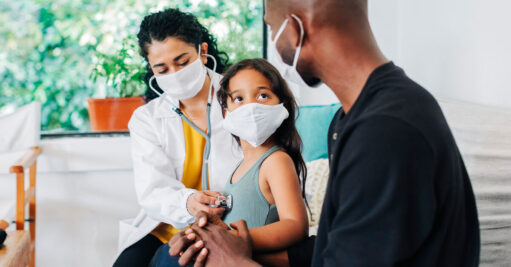No products in the cart.
HEALTH BLOGS BY FITBYNET
Omicron in Children: Things Which Parents Must Know
Anti-allergic medicines as prescribed by your doctor should be regularly given.
Anti-allergic medicines including cetirizine, levocetirizine, fexofenadine and loratadine, etc., have well-documented effectiveness in children. They help in relieving congestion, runny nose, and mucus buildup. Remember, do not treat your kids on your own or with your medicines. Follow dosage as advised by your child specialist.
Know the warning signs: When a fever may need hospitalization
Visit the child specialist if your child is younger than 3 years of age or have any of the following:
– Extreme lethargy, drowsiness, excessive cry or irritation
– Headache, neck stiffness, or breathing difficulty
– Abnormal body movements or behavior
– Temperature above 104°F
– Fever persisting for more than 5 days
Similarly, in a child with fever, the following signs should make you relaxed:
– Playful and active during interfebrile period
– Acts like himself/herself during most of the day
– Feeding well
– Passing urine normally
RT-PCR can be negative in the early days of illness
– Your child may have classic COVID symptoms like fever, cough, however, the gold-standard RT-PCR test report could be negative.
– One possible explanation is that the testing happened too early. Though RT-PCR test is extremely sensitive, a certain threshold of viral particles must be reached before the test can catch it.
What can you do about it?
The optimal timing for RT-PCR tests is 2-4 days after the onset of symptoms, although many kids can test positive sooner than this.
If your child has COVID-like symptoms in the current situation of the third wave, consider it as COVID and take all precautions accordingly. Make sure to connect to a doctor and get guidance.
Stick to the basics: Comfortable clothing, sponging, and hydration
– Dressing: It is a natural reflex to cover the child with multiple blankets and warm clothings as chills or shivering comes. Do not overdress or put extra blankets on. Let the clothes be comfortable. Excess clothing tends to trap body heat and cause the temperature to rise.
– Sponging: Use tepid water (neither hot nor cold to the touch) for sponging from head to toe for 15 mins after giving the fever medication. DO NOT use ice-cold water. To get the most out of it, keep the water film moving over the body (and don’t hold too much at one body area) for maximum temperature regulation.
– Hydration: Optimum fluid intake is very important. As a natural response to fever, the body attempts to lower the temperature naturally through extensive sweating. If your kid doesn’t take enough fluids to replenish, he/she is likely to get dehydrated. Give lukewarm water as small, multiple sips. It helps bring down the core temperature and prevents dehydration too.
Paracetamol and Ibuprofen are medicines used in children for bringing the fever down.
Paracetamol is the safest anti-fever medicine for children. The dose can be repeated after 4–6 hours. Sometimes a combination of paracetamol and ibuprofen is given to have a rapid response. Do not use aspirin or nimesulide for fever relief in children. (These are two commonly used medicines for minor pain and fevers in adults.)
If paracetamol appears unable to bring down the fever, remember these:
– If the initial fever was high, say 104°F, administration of paracetamol may bring it down to 101°F and not make the child afebrile. If you see a downward trend in temperature, consider it is working.
– Remember, the purpose of fever medicine is not to bring down the temperature to normal level but to provide symptomatic relief to the child by reducing pain and discomfort.
– Avoid overdosing if the fever does not normalize. You can repeat the next dose after 4–6 hours if required.
– Paracetamol may start showing effect within 15-30 mins. The maximum effect comes after nearly 1.5 hours.
– Paracetamol dosing depends on your child’s weight (and not age) and strength of medicine. Adequate dose of paracetamol for kids is 10-15 mg/kg. Different strengths of paracetamol syrups are available to cater to diverse pediatric needs. This helps reduce the amount/volume of syrup to be given and could be helpful.
– Other medicines (ibuprofen, mefenamic acid) are also available and should be used only in consultation with your pediatrician.
– Do not panic. Meanwhile, use tepid sponging. Adjust clothing if it is too tight or dressed up.
For more informational health blogs, please check our Health Blogs section!

